|
|
|
[Bibliothèque Nationale]
DU MANUSCRIT CAROLINGIEN AU LIVRE d'AUJOURD'HUI
Un ouvrage de 132 pages, format 155 x 205 mm, illustré, broché couverture couleurs, publié en 1969, Impr. Tournon et Cie, bon état
Referencia librero : LFA-126728938
|
|
|
[BIBLIPHILIE, MANUSCRIT] - RIOU (Gaston) -
EUROPE MA PATRIE.
S.l., L'auteur, 1928; in-4, EN FEUILLET SOUS JAQUETTE. MAMUSCRIT - PLUS TEXTE MACHINE ORIGINAL avec correction manuscrite - joint -PRÉIMPRÉMATURE - (GASTON RIOU, journaliste positiviste combattant au front - 14-18, milite pour l'europe fédérale en 1920-29 "EUROPE MA PATRIE" existe une édition en Allemand par Marguerite Wolf avec préface de Renée Schickele Ed. Heitz strasbourg 1929 (il parle de l'historique de Charlemagne 1er Empereur franco germanique europeen -- Aristide Briand /Stresemann développe les thèses européennes avec 50 ans d'avance.
Referencia librero : 200918882
|
|
|
[BLIN de SAINMORE ] / [MANUSCRIT]
Lettre de la Duchesse de La Vallière à Louis XIV précédée d'un abrégé de sa vie.
S.l.n.d. (ca 1780). 1 vol. in-12, cart. bradel, pièce de titre en long au dos. Reliure moderne. 57 pp., galerie de vers avec qq. atteintes au texte.
Referencia librero : 17452
|
|
|
[BLONDEAU (Nicolas), Noël (François)].
[Manuscrit]. Dictionnaire érotique contenant l'interprétation de tous les mots libres des anciens auteurs et de ceux de la basse latinité ; les détails de la Toilette des dames grecques et romaines ; les noms et les anecdotes des Courtisanes célèbres de Grèce et de Rome, où des personnages connus en ce genre, ainsi que des rapprochements avec les moeurs et les personnages modernes. Ouvrage nécessaire à la connaissance de l'Antiquité.
Lampsaque, , 1799. 2 vol. in-4 manuscrits de (241) et (269) ff., becquets dans le texte et sur un contreplat, demi-basane blonde à petits coins de vélin, dos lisse orné, pièces de titre en maroquin rouge et noir (reliure de l'époque).
Referencia librero : 43266

|
|
|
[BOISSEVIN Louis]:
Portraits des rois de France. Depuis Pharamond jusques Louis XVIII.
Paris, Louis Boissevin, [1660]. In-4 de 66 feuillets, plein vélin ivoire.
Referencia librero : 17510
|
|
|
[BONNECORSE (Balthazar de)]
Lutrigot, poème héroï-comique
1785. Manuscrit de 68 pp., titre manuscrit encadré (quelques rousseurs).
Referencia librero : 8788
|
|
|
[Book of Hours].
[Liber horarum - Use of Rouen]. Rouen, Maître de l'échevinage (workshop), ca. 1480 (last quarter of the 15th c.).
8vo (190 x 133 mm). Latin manuscript (lettre batarde) on vellum. 2 columns, 25 lines. 70 (instead of 74) ff., with 2 ff. of flyleaves at beginning and end each. Floral borders in colours and gilt; ornamental initials; 10 (instead of 14?) illuminated pages. 16th century calf with gilt double cover rules and central oval stamps (upper cover: crucifixion; lower cover: annunciation). Splendidly illuminated Northern French Book of Hours on vellum. The nearly full-page miniatures (ca. 110 x 80 mm) show extended landscapes as well as interiors, comprising: fol. 14r, Annunciation (at the beginning of the matin of the Office of Mary); fol. 20r, Visitation (Lauds); fol. 26r, Crucifixion (Hours of the Cross); fol. 27r, Pentecost (Hours of the Holy Spirit); fol. 31r, Adoration (Sext), fol. 33r, Presentation at the Temple (None); fol. 35r, Flight into Egypt (Vespers); fol. 38, Coronation of Mary (Compline); fol. 41v, King David in prayer (Penitential Psalms); fol. 50v, Job (Office of the Dead). Wants 4 leaves: before fol. 7 (Gospel lections), before fols. 28 & 30 (Prime and Terce in the Office of Mary), and before fol. 65 (beginning of a prayer to the Blessed Virgin). The finely gilt accents on the figures' clothing are typical of the French book illumination of the period. The borders (on all sides of the first calendar page and surrounding the miniatures, otherwise only to the outside of the text) show characteristically elongated, light brown and blue tendril leaves as well as blossoms and fruits (mainly strawberries and oblong red blossoms) within light brown compartments. The various prayers and lections have small coloured initials; final paragraph lines are completed with red and blue bars bearing gilt decoration. - The localisation of this Book of Hours is conclusively demonstrated by the original note on fol. 13r: "Hore beate Marie virginis secundum usum Rothomagansem" (i.e., Rouen in Normandy). Liturgically of high importance is the calendar (fols. 1r-6v), written in French: the entries are alternately in red and blue, feasts are emphasized in gilt. Names include St Martialis, bishop of Limoges, celebrated in Rouen on 3 July and also prominently mentioned in the litany; St Romanus, bishop of Rouen (23 October); and other bishops of Rouen, such as Ansbertus (9 February), Hugo (9 April), Mellonus (22 October), and numerous saints typical for the region, some of which reappear in the litany (fols. 47v-50r). - The localisation is supported by the art-historical evidence: the tendril forms were developed in Rouen around 1460 by the "maître de l’échevinage", and his highly productive workshop continued the tradition until the 16th century. The compositions and their arched top borders further support this attribution. The date is suggested by the lack of bars in the borders, such as are typical of workshop's ornamentation as late as in the third quarter of the 15th century, and on the other hand by the unadulterated Gothic character of the illumination, which in Rouen tends to give way to Renaissance motifs even in the late 15th century. - Provenance: 16th century old French entries on fol. 70v, concerning the birth of several children of the book's owner. The first entry mentions a fourth son, Pierre, born on 13 May 1563; by 1570 he is followed by four more children who were apparently entered immediately after their birth. While the family's name is not stated, it might be identified from the names of the godparents. An added prayer entered on fol. 13v appears nearly contemporary with these notes. - Occasional very insignificant paint smudges and offsetting to opposite pages with a few very minor stains. Altogether in fine state of preservation.
|
|
|
[Bossuet - Manuscrits] PORCHER, Jean
Catalogue des manuscrits de Bossuet de la collection Henri de Rothschild / rédigé par Jean Porcher... ; Préface de M. Eugène Levesque...
Paris, émile-Paul frères, Henri Darel 1932 In-4 33 x 25,5 cm. Broché, couverture grise rempliée, dos muet, titre en noir sur le premier plat, XXIV-109 pp., notes en bas de page, en frontispice, portait de Bossuet, par Robert Nanteuil, 13 fac-similés contrecollés sous serpentes, index, table des planches, table des matières. Exemplaire en bon état.
Referencia librero : 108728
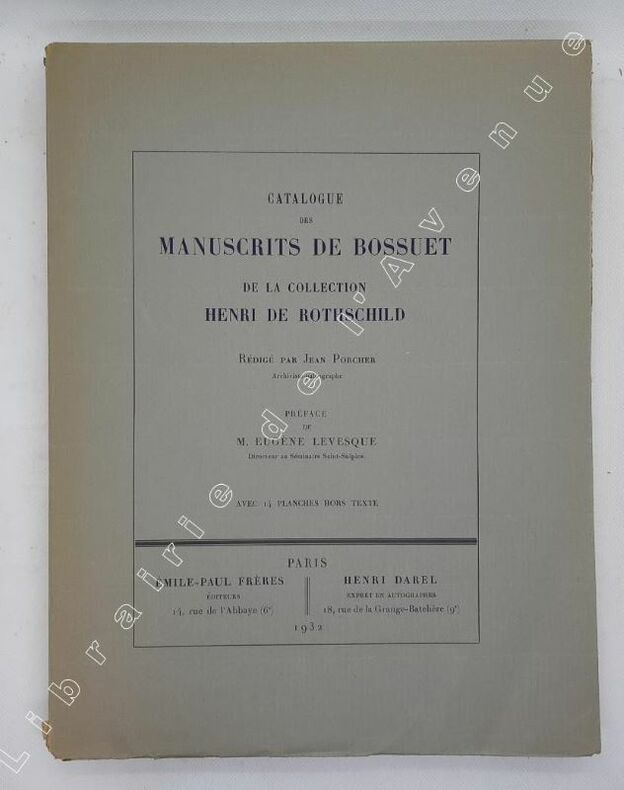
|
|
|
[BOUILLY (Jean-Nicolas)].
Comédie historique de l'Abbé de l'Épée écrit d'après l'original par Jean H. Wouters.
, , 1815. Manuscrit in-12 de (1)-140 pp., titre orné, vélin souple bruni, dos lisse muet (reliure de l'époque).
Referencia librero : 43352

|
|
|
[BOULANGER EN PAIN D’ÉPICES] - MANUSCRIT
Inventaires après décès de Madeleine Granier, femme de Louis Chasteau, boulanger en pain d’épices, demeurant à Fontainebleau, Grand’Rue.
17 Février 1670. 6 feuillets in folio (angle extérieur du bas atteint par l’humidité).
Referencia librero : 10049
|
|
|
[BOURBON-CONDE Louise-Anne de] & SADE Donatien Alphonse François, Marquis de & SADE Jean-Baptiste-François-Joseph, comte de
Testament
- Paris dimanche 2 avril 1758, 13,4x19,2cm et 11,7x17,8cm, 2 feuillets. - Testament de Louise-Anne de Bourbon-Condé dite Mademoiselle de Charolais, recopié de la main de Jean-Baptiste-François-Joseph, comte de Sade (et père du Marquis), dans lequel cette dernière fait de son neveu, Louis-François Joseph de Bourbon, prince de Conti, son légataire universel. Une seconde partie concerne les legs aux gens de livrée, aux femmes et valets de chambre, à la femme de garde-robe, etc. Note de bas de page de la main du Marquis de Sade : « dite Mademoiselle de Charolais ». On y joint un billet de notes, rédigé de la main de Sade, en vue de la publication de la correspondance de son père. Ce testament a été rédigé cinq jours avant la mort de Mademoiselle de Charolais, dont le décès survint le vendredi 7 avril 1758 à la suite de trois mois de maladie. La seconde partie du testament est datée du dimanche 2 avril 1758, sur la première est mentionnée la date du dimanche 12 avril 1758 : il s'agit bien sûr d'une date fautive. La totalité de cette copie a été rédigée de la main du Comte de Sade qui vécut avec Mademoiselle de Charolais à son château d'Athis-Mons à partir de 1750 jusqu'à la mort de cette dernière. Le jeune Comte de Sade, envoyé par son père à Paris aux alentours de 1720, eut pour protecteur Louis-Henri de Bourbon, Prince de Condé, dit Monsieur le Duc. Dès son arrivée, le jeune homme apprécie la vie de cour et « Chose rare, il plaît aux femmes sans se faire haïr des hommes : d'où le nombre de ses amis, au moins aussi élevé que celui de ses maîtresses. [...] M. de Sade ne se contente pas de conquêtes faciles ; les bourgeoises l'indiffèrent. Celles qu'il recherche - et conquiert le plus souvent - sont des femmes de cour, non seulement pourvues d'esprit et de beauté, mais parées encore d'un nom illustre, de crédit, d'influence ou de fortune, capables en un mot de servir ses intérêts et de le mettre bien en cour. » (Lever, Sade). Parmi son tableau de chasse figure Mademoiselle de Charolais, de sept ans son aînée, soeur de son protecteur et alors maîtresse royale. Peu désireuse de se marier, elle préférera toute sa vie conserver le célibat et multipliera les aventures et les amants prestigieux. Elle fut notamment la favorite du Duc de Richelieu, mais aussi de Louis XV pour lequel elle recrutait de nombreuses maîtresses, écopant ainsi du sobriquet de « maquerelle royale ». La rencontre charnelle entre Mademoiselle de Charolais et le Comte de Sade eut lieu le 24 novembre 1725 alors que ce dernier était contraint de garder le lit à cause d'une entorse. Une lettre de Louise-Anne atteste de cette aventure naissante : « Le 24 novembre est le plus beau jour de ma vie si je suis rentrée en possession de mon royaume et de ma souveraineté, par les droits du lit où je vous ai prêté serment de fidélité. Je compte y avoir reçu le vôtre et je vis maintenant pour le plus joli roi du monde. » (Papiers de famille, p.20). La passion n'est pourtant pas réciproque et le volage Comte de Sade fait bientôt la rencontre de la Duchesse de la Trémoïlle. S'éloignant ainsi de Mademoiselle de Charolais, il lui écrit en guise de rupture : « J'ai regardé, Madame, les avances que vous m'avez faites, comme des agacements de votre esprit et point de votre coeur. Je n'avais point l'honneur de vous connaître, je ne vous devais rien, une entorse m'obligeait de garder ma chambre, j'y étais désoeuvré, vos lettres étaient jolies, elles m'amusaient, je me suis flatté s'il était vrai que j'eus fait votre conquête, que vous me guérissiez d'une passion malheureuse qui m'occupe uniquement. » (op. cit. p.23). En 1752, le Comte de Sade est ruiné par son train de vie, il a envoyé le jeune Donatien au collège Louis-le-Grand et loge chez sa bonne amie Mademoiselle de Charolais au château d'Athis-Mons : « Je me suis retiré chez Mademoiselle, quoiqu'il soit cruel à mon âge de dépendre de quelqu'un, pour diminuer ma dépense. » (Lettre du Comte de Sade à son oncle le prévôt

|
|
|
[BOURCET (Pierre-Joseph de)].
Mémoires concernant les frontières de Piémont, de Savoye et de l'Italie où se trouvent tous les cols et passages des Alpes depuis le Mont-Cenis jusqu'à la vallée de Barcellonnette, les passages des monts Apennins, depuis le Col de Tarde à hauteur de Nice jusqu'au MontZova à la hauteur de Florence, de la coste de la mer depuis Nice jusqu'à Livourne. Pour servir d'instruction aux marches, mouvemens et campements des armées. Avec un détail des places de la Provence, du Dauphiné, du Piémont, du Milanais, du Mantouan, du Modénois, du Parmesan, et des subsistances qu'on peut trouver dans l'Italie.
, Sans lieu ni date, [1747]. In-folio de 1 titre, 332 pp. (saut de chiffrage de 154 à 147), [3] ff.n.ch. de table, veau brun marbré, dos à nerfs cloisonné et fleuronné, encadrement de double filet à froid sur les plats, double filet doré sur les coupes, tranches rouges (reliure de l'époque).
Referencia librero : 39721

|
|
|
[BOURGOGNE]
[BEAUMONT-LA-FERRIERE] [NIEVRE]. Vente de nombreux arpents de terre.
Cahier sur parchemin du XVIe siècle (1595), gr. in-4 de 20 pp. manuscrites.
Referencia librero : 576696

|
|
|
[BOURGOGNE] [BAILLAGE DE LA MONTAGNE]
Pièce manuscrite du XVIIe, in-8 oblong (29x12 cm). Acte de vente entre Pierre Richot laboureur demeurant à Belan et Edme Boulet demeurant à Chaource.
Referencia librero : 573584
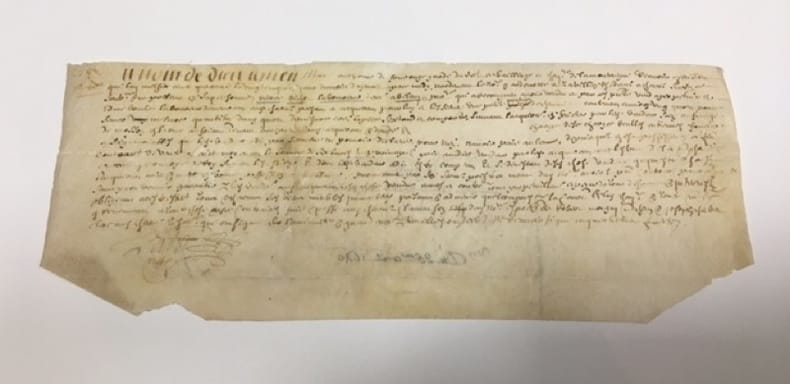
|
|
|
[BRETAGNE] [BUSNEL Jacques]
Résignation d’une charge de président aux enquêtes du parlement de Bretagne faite par Jacques Busnel, seign. de la Guynemenière à Louis Bouju seign. de la Me(s)nellière (marié à Lucrèce Ménardeau), 20 Janvier 1644.
Document manuscrit in-folio de 12 pp. sur pap. vergé.
Referencia librero : 573864
|
|
|
[British Army].
Establishments of His Majesty's Land Forces 1765. No place, [ca. 1765].
8vo. English manuscript on paper. (2), 34 (switching between foliation and pagination on the last 10 leaves), (1) ff. With a slip of paper attached to folio 11. Contemporary full red morocco with giltstamped border and spine. All edges gilt. Precisely drawn tables filled out in meticulous handwriting, listing forces in Britain and overseas including infantry, cavalry, general staff, garrisons in Gibraltar, Minorca, North America, and the West Indies, noting daily and annual salaries and other expenses. - After folio 22 the scribe occasionally switched to pagination, resulting in page numbers 23-24, 26-27, 29-30, and 32-33. - Spine slightly rubbed; interior crisp and clean. Contemporary ownership to flyleaf: "H. Leece | War Office | 1 Dec[embe]r 1777". Later in the collection of Thomas Fremantle, 3rd Baron Cottesloe (1862-1956), commander of the Territorial Army and president of the Society for Army History Research.
|
|
|
[British Army].
Returns of His Majesty's Forces at 1 August 1807. No place, [ca. 1807].
4to. English manuscript on paper. (2), 43, (1) ff. Contemporary full red morocco with giltstamped border and spine. Endpapers marbled. All edges gilt. Pre-printed table filled in by hand, detailing British military forces stationed in Britain and around the world, including the Caribbean, India, Africa, and Australia. Includes the names of regiments as well as the numbers of commissioned and non-commissioned officers, and the enlisted rank troops ("Rank & File"), distinguishing those fit for duty from those on the sick list, with a total of 238,978 regular forces and 91,586 militia. - Binding insignificantly rubbed at the hinges; interior crisp and clean. Heraldic bookplate incorporating a ducal coronet and Bentinck family crest to pastedown, a pencil note on the flyleaf ascribing it to the Duke of Portland's library. Later in the collection of Thomas Fremantle, 3rd Baron Cottesloe (1862-1956), commander of the Territorial Army and president of the Society for Army History Research.
|
|
|
[BROCHET DE VÉRIGNY, Marie Clémence ?]
[Catalogues des bibliothèques de La Rochemacé]
[Couffé] [1826-1868] In-8° (229 x 193 mm) [3] ff. bl. - [4] ff. manuscrits - [21] ff. bl. - [5] ff. manuscrits - [10] ff. bl. - [6] ff. manuscrits - [1] f. bl. - [65] ff. manuscrits au recto - [2] ff. bl. - [23] ff. manuscrits au recto - [8] ff. bl. - [8] ff. manuscrits - [2] ff. bl. - [23] ff. manuscrits - [2] ff. volants, encre brune, papiers filigranés au cornet « Jan Kool » ou au cornet « VAN DER LEY », basane marbrée, dos lisse orné, tranches à mouchetures rouges (reliure de l'époque)
Referencia librero : 286

|
|
|
[Brooklyn].
Deed from William Morris and wife to the Corporation of New York. Signed by William and Rebecca Morris. Breuckelen (Brooklyn), Long Island, 12. X. 1694.
English manuscript on vellum. Approx. 620 x 555 mm (with folded plica). With two red seals. Stored in a custom-made half morocco case with gilt-stamped spine. Original deed of the first substantial purchase of land on the Brooklyn side of the East River ever made by the New York municipality, a purchase that was called by Henry E. Pierrepont (1808-88), director and historian of the Union Ferry Co., "the foundation of the claim of the City of New York to their land in Brooklyn" (23). After the capture of New Amsterdam from the Dutch in 1664, a municipal government had been formed, the Corporation of New York, while across the water, "Breuckelen" (as it was then called) long remained an independent, rival city on its own. - "As early as the 12th of October, 1694, the Corporation of New York purchased from William Morris, for no specific consideration, his hourse, barn and premises, situated at the 'Ferry', on Long Island. The house stood on the north side of the road, opposite the present Elizabeth Street, about one hundred feet from the then shore of the river" (Pierrepont, 16ff.). The site was then known as "Brookland Ferry", the place where George Washington escaped with his troops after the Battle of Long Island. It adopted its modern name, Fulton Ferry, when in 1814 Robert Fulton established the first steam ferry route connecting Manhattan and Brooklyn, which played such a major role in their shared history and evolution. - Incipit: "This Indenture, made the twelfth day of October, in the sixth year of the reigne of our Sovereigne Lord and Lady, William and Mary, by the grace of God, of England, Scotland, France, and Ireland, King and Queen, defenders of the faith etc., and in the yeare of our Lord one thousand six hundred ninty and four, between William Morris, now of the Ferry, in the bounds of the towne of Breuckle, in Kings county, on Long Island, gent., and Rebecca his wife, of the one part, and the Mayor, Aldermen and Commonalty, of the City of New York of the other part [...]". - Two copies of the deed would have been made, and this appears to be the deed retained by the Morris family and heirs, with an early note indicating that it was also "recorded in the Office of the Town of Clerk of City of New York in the Book of Grants". Pierrepont, writing in 1879, was still able to locate the City's copy at the Office of the Comptroller, where it may have remained until 1910, when such documents were transferred to the New York State Library; it probably perished in the notorious archive fire of 1911. - Drafted and signed by Ebenezer Wilson, later Mayor of New York City (1707-10). Verso signed additionally by William Pinhorne (d. 1720), the American colonial politician and jurist. Folded, few small tears to folds with negligible loss. Gabriel Furman, Notes, Geographical and Historical, Relating to the Town of Brooklyn, in Kings County on Long Island (Brooklyn, 1824), Appendix A, pp. 102f. (published in part). Henry Evelyn Pierrepont, Historical Sketch of the Fulton Ferry, And Its Associated Ferries (1879), pp. 16-23.
|
|
|
[Buddhist manuscript].
Sutra. Burma, [ca. 1896 ].
600 x 65 mm. 21 palm leaves between two painted wooden boards with cord. Burmese manuscript in Pali, most likely a register of Buddhist monastic rules. - Signs of age.
|
|
|
[Buddhist manuscript].
Sutra. Tibet, 18th/19th century.
340 x 100 mm. Manuscript on ca. 240 palm leaves between two wooden boards. In the original wrapping cloth. Signs of age.
|
|
|
[Buddhist manuscript].
Sutra. Tibet, 19th century.
355 x 90 mm. 38 ff. Printed from woodblocks, all edges red.
|
|
|
[Béret (Michel)]
Images d'Alsace. 12 burins de Michel Béret, présentés par André Warnod.
Paris, au dépens d'un groupe d'Amateurs, chez l'Artiste, 18, rue Barbet de Jouy à Paris, (1949) ; petit in-4° (284 mm) en feuilles sous couverture crème illustrée rempliée, chemise : feuillet double décoré de branches verticales de feuillage bleu ou rouge alterné, [12] pp. de faux titre, titre, table des gravures et justificatif, 12 burins sur vélin d'Arches pur fil, numérotés en chiffres romains et placés dans un passe-partout avec fenêtre (burins 25 x 16 cm ; cuvette 10 x 6,5 cm).
Referencia librero : 21563
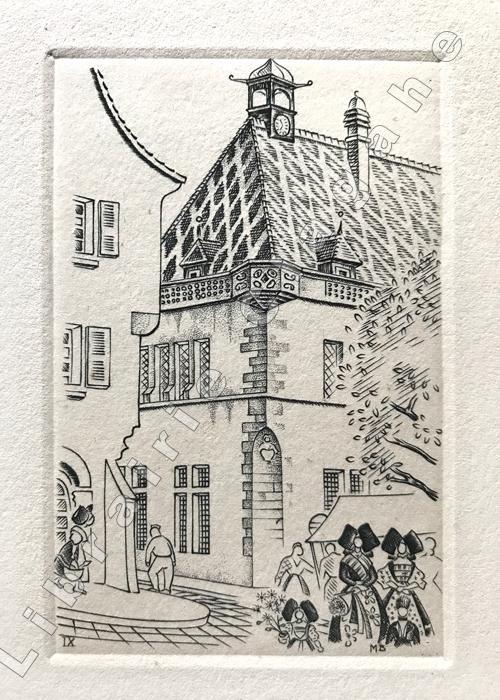
|
|
|
[CALLIGRAPHIE - MANUSCRIT] GIRAUD (F. B.)
Cahier d’écriture pour le concours de l’année 1840 par F. B. Giraud élève des frères des Écoles Chrétiennes d’Avignon.
in-plano (40 x 53 cm.), demi-chagrin rouge de l’époque. 13 ff., texte sur le rectoSuperbe exercice de calligraphie où l’élève montre la variété de caractères, de formats et d’ornements qu’il sait réaliser. Les textes sont des textes religieux ou des extraits d’ouvrages de morale : paraphrase du Salve Regina, anecdotes contre les philosophes concernant d’Alembert, Malesherbes, etc. Les textes de divers formats sont dans de beaux encadrements au trait de plume, certaines pages montrent la variété des styles calligraphiques : ronde, anglaise, gothique.Reliure fortement endommagée, l’encre de certaines pages a déteint sur le verso blanc en regard ou en formant des auréoles sur la page de texte, accident réparé dans la marge inf. du titre.
Referencia librero : 46405296

|
|
|
[CARTES POSTALES].
Cinq jours de voyage.
1907 S.l., septembre 1907, album manuscrit sous reliure percalinée vert pomme, pièces de titre et tomaison en maroquin brun, non paginé.
Referencia librero : 17720
|
|
|
[CATALOGUE MANUSCRITS] - SOURGET (Patrick et Elisabeth) -
Librairie SOURGET MANUSCRITS ET LIVRES PRÉCIEUX CATALOGUE XXIV.
CHARTRES, Librairie Sourget, 2002; in-4, 623 pp., cartonnage de l'éditeur.
Referencia librero : 202004729
|
|
|
[CATÉCHISME DE PERSÉVÉRANCE - Marguerite NEVEU-LEMAIRE].
CATECHISME DE PERSEVERANCE de Margueritte NEVEU-LEMAIRE MANUSCRIT XIXe siècle.
4 vol. in-8 (22,2 x 17), datés 1895, 1897, 1898 et 1899 au dos. Composés de cahiers de 8 ff (parfois 10) non chiffrés (180 à 200 feuillets par volume). Chacun cahier débute par le nom de la catéchumène, sa place dans l'église (côté de l'épitre 2ème banc) et en dessous est collée une vignette imprimée en rouge ou doré de la paroisse Saint-Augustin à Paris. Au premier volume il représente dans un médaillon ovale, un ange guidant vers la lumière un enfant, en dessous est inscrit "catéchisme du jeudi". Dans les autres volumes l'étiquette lithographiée (un A et un M entourés de fleurs, et surmontés d'une couronne d'étoiles rayonnantes) de la Paroisse Saint-Augustin, porte la marque de l'imprimerie de Victor Gourbeyre, 3, rue d'Alger à Paris (imprimeur né dans le Puy-de-Dôme le 28 avril 1827). Le volume daté de 1898 contient en plus un "grand cachet" de la paroisse Saint-Augustin, représentant en pleine page, dans un ovale le saint devant l'église parisienne encadré par deux anges (Lithographie de Gourbeyre). Demi-basane noire, dos lisses, filets dorés. Titre au dos : Analyse de catéchisme de persévérance - Date Margueritte Neveu-Lemaire Paroisse St-Augustin. Le volume de 1895 port au dos le titre de "Analyse de catéchisme de 1ere communion". Etiquette de reliure sur le contreplat sup. du premier volume : Cornette-Badin à Clamecy (Nièvre). Des traces de mouillures légères et rousseurs éparses. Frottement marqué au dos d'un des volumes (reteinté).
Referencia librero : 13611

|
|
|
[Certificat militaire] Chevalier de LARROUX - Maitre de Camp de Cavalerie - Aide major des Gardes du Corps
Certificat fiscal : "Certifions que M. D. LAGARDE DUCHASSAT, garde du corps..., y a payé la capita(n)tion depuis le moment de son entrée au corps qui est en 1764..."
Manuscrit sur papier (19,5 X 15,5 cm) avec cachet de cire rouge signé, situé et daté : "à Beauvais le 15 mai 1784" -
Referencia librero : GF15380
|
|
|
[Certificat militaire] DAMIGNY Chevalier - colonel commandant le régiment de Saintonge
Certificat pour le "sieur de Ste MARIE présentement sergent dans le régiment de Chessé" qui a "servi en celui de Saintonge pendant l'espace de 5 ans"
Manuscrit sur papier (10 X 16,5 cm) avec cachet de cire rouge signé, situé et daté : "à Givet le 12 avril 1694" -
Referencia librero : GF15406
|
|
|
[Certificat militaire] DELRUE - lieutenant colonel commandant le régiment d'infanterie du Languedoc
Certificat pour "le nommé CLERMONT soldat de la Compagnie Desfosseux" qui y a servi"depuis l'an 1672".. et qui "est un brave soldat" -
Manuscrit sur papier (16,5 X 21,5 cm) avec cachet de cire rouge signé, situé et daté : "au camp de Neuf Brisack le 31 octobre 1699" -
Referencia librero : GF15415
|
|
|
[Certificat militaire] Marquis de WARTIGNY - Maitre de camp d'un régiment de Dragons
Certificat pour "Monsieur de BONAVENTURE" qui sert actuellement en qualité de lieutenant d'une compagnie dans mon régiment -
Manuscrit sur papier (16,5 X 22 cm) avec cachet de cire rouge signé, situé et daté : "à Longwy le 9 mai 1699" -
Referencia librero : GF15411
|
|
|
[Certificat militaire] REMONTEVILLE - Lieutenant colonel commandant le Régiment de Cavalerie Davillier -
Certificat pour "le nommé BRINDAMON" qui"a servi l'espace de 24 ans dans ledit régiment"-
Manuscrit sur papier (15,5 X 19,5 cm) avec cachet de cire rouge signé, situé et daté : "à Camby le 23 octobre 1699" -
Referencia librero : GF15414
|
|
|
[Champsavin (Louis Marie Joseph Le Beschu de ; 1778-1867)]
28e D (28e dragons). Notes sur l'instruction à cheval.
Sedan, imprimerie Emile Laroche, 1904 ; petit in-8°, broché, 62 pp., couverture saumon imprimée, 2 croquis in-texte.
Referencia librero : 22351
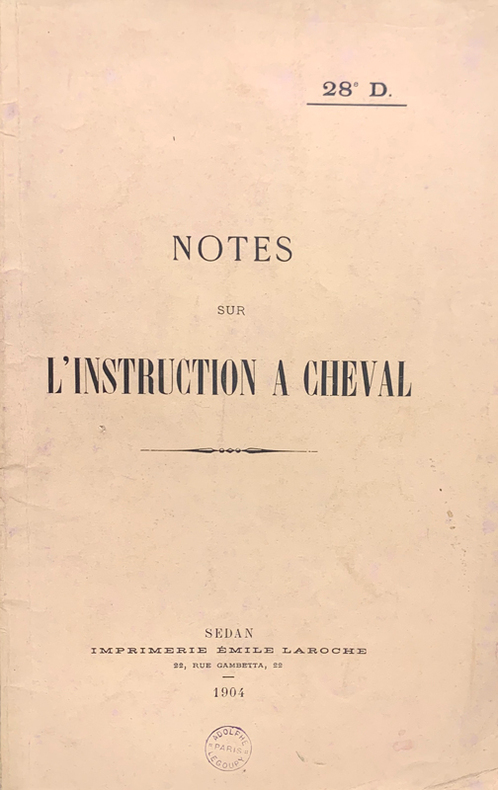
|
|
|
[CHANSONNIER MANUSCRIT]
Recueil de toutes sortes de pièces curieuses et satiriques, chansons, dialogues, epigrammes et sonnets.
1715. 1 vol. in-folio. 80 ff. Veau d'époque, dos à nerfs orné, pièce de titre de maroquin rouge, roulette dorée sur les coupes et intérieure.
Referencia librero : 12950

|
|
|
[Chemie].
Chemische Charactere. O. O., 1823.
Deutsche Handschrift auf Papier. 8 Bll. (inkl. Umschlag). Lateinische u. deutsche Kursive in brauner Tinte. Geheftet. 8vo (102 x 163 mm). Enthält chemische Symbole und ihre Bedeutung in lateinischer und deutscher Sprache. - Auf bläulichem Papier. Meist stockfleckig oder gebräunt.
|
|
|
[China - logbook].
Journal geführt an Bord des Bark Schiffes Anna / Capitain C. Eisenmenger / auf der Reise von Hamburg / nach Shanghay. (Printed form: Hamburg, C. Plath, D. Filby Nachfolger), 1869-1872.
Small oblong folio (ca. 276 x 210 mm). German manuscript on paper (letterpress form). 188 ff. Contemporary brown half cloth over marbled boards with giltstamped red cover label reading "Journal. 12 Monate". Diligently kept naval log of a long China voyage on a Hamburg-based ship undertaken soon after the Second Opium War, at the time of the Tianjin Massacre, during the early years of the rule of the Tongzhi Emperor. The Chinese ports of call range from Hong Kong on the South China Sea and Shanghai on the East China Sea to Tianjin (near Beijing) on the Yellow Sea. - The journal entries begin with the schooner barque Anna weighing anchor in Hamburg on 17 January 1870; they cross the Sunda Strait on 23 April and reach Shanghai on 1 June. After a layover, the course is set for Tamsui, then for Chifoo (Yantai) and Tientsin (Tianjin), and onwards to Hong Kong, Amoy (Xiamen), and Taku, bringing the ship to the island of Penang (George Town) on the Straits of Malacca on 12 March 1872. 14 pages prefixed to the printed form describe how the Anna is taken over at Geestemünde (Bremerhaven) on 20 November 1869, as well as the travel preparations, but also events in the port of Yantai. Apart from precise position readings, weather notes, and other navigational records, the book also contains information in brief regarding disciplinary measures, damage suffered from ice jams, celebrations on board, etc. Until 21 June 1870 the logbook is maintained by the chief helmsman Thomas Brügeman, after which date a different writer takes over. - The Anna (ex Malvina), built and launched in 1859, was a barquentine of 227 register tonnes, sailed by a crew of ten men under captain Carl Eisenmenger, who was also the owner of the ship. - Binding slightly rubbed; paper occasionally browned, but well-preserved altogether.
|
|
|
[China]. - Douglas, Robert Kennaway
Catalogue of Chinese Printed Books, Manuscripts and Drawings in the Library of the British Museum.
London, Longmans & Co., 1877. Gr.-4°. VII (1), 344 S., OLwd. m. goldgepr. Rückentitel.
Referencia librero : 48107
|
|
|
[Chine] Bibliothèque nationale (France). Département des manuscrit
Catalogue des manuscrits chinois de Touen-Houang. Volume IV, Nos 3501-4000 : fonds Pelliot chinois de la Bibliothèque nationale. / [réd. sous la dir. de Michel Soymié ; publ. de l'Équipe de recherche sur les manuscrits de Dunhouang, École pratique des hautes études]
École française d'Extrême-Orient, coll. « Publications hors série de l'École française d'Extrême-Orient » 1991 Fort in-8 24,5 x 16 cm. Broché, couverture jaune, titre en sépia sur le dos et le premier plat, XX-558 pp., table des matières. Exemplaire en bon état.
Referencia librero : 122452
|
|
|
[Chièze] Roux, Catherine :
Triangle rouge, illustré par Jean Chièze.
Lyon, M. Audin, 1946 ; in-8 carré, broché ; 230 pp., (1) f. (achevé d'imprimer) ; 1 illustration en frontispice, quelques illustrations in-texte ; couverture blanche imprimée rouge et noir.
Referencia librero : 2238
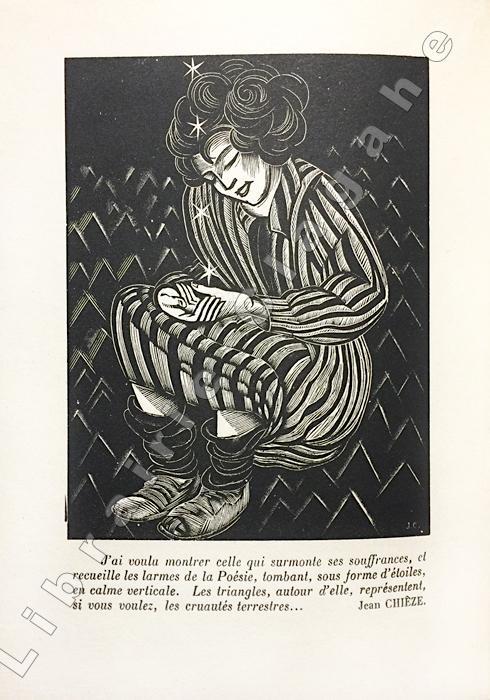
|
|
|
[CHRISTIANISME].-
Sur les Superfétations apportées à la religion révélée par Jésus-le-Christ de l'An à 500.-
Manuscrit anonyme, sans lieu ni date, sans doute fin XIX°. In-f°br. (19x30cm), 40ff. n.ch. et 4 ff. blancs. Couverture brunie et fragilisée mais intérieur frais et écriture très lisible.
Referencia librero : ORD-2289
|
|
|
[Chromometer].
Deutsche Handschrift auf Papier. O. O. u. D., [um/vor 1777].
2 SS. Folio. Instruktive Darstellung der Funktionsweise eines Chromometers, die wohl für einen Lexikonartikel oder als Aufsatz für eine technische Zeitschrift gedacht war: "Chromometer, Chromoskop oder Wärmemesser wird ein Instrument genannt, welches die Änderungen in der Wärme oder Temperatur der Luft oder eines andern Fluidums, dem es ausgesetzt, wird, genau anzeigt. Diese Kenntnis der abweichenden Temperatur ist bey mehreren ökonomischen Geschäften höchst wichtig; sie kann auch in einer regelmäßigen Bleich- und Färbeanstalt, wo man nicht auf[s] geradewohl operirt, und immer gleiche Resultate verlangt, nicht enbehrt werden; aber nur durch jenes Instrument wird sie möglich. So wie die Aräometer, so sind auch die Thermometer nach der Eintheilung ihrer Skalen verschieden. Die gebräuchlichsten sind das Reaumürische und Fahrenheit Thermometer, deren Eintheilung hinlänglich bekannt ist [...]". - Verfasser des vorliegenden Manuskripts ist "Fritz v. Meiding[er]" - so die Unterschrift unter dem Text -, wohl ident mit dem Gelehrten, Naturforscher und Erfinder Johann Friedrich Reichsfrhr. von Meidinger (1726-1777).

|
|
|
[CINGRIA]
Charles-Albert Cingria 1883-1954.
Lausanne, Revue de Belles-Lettres, 1966. Gr. in-8°, 73p. Broché.
Referencia librero : 40404
|
|
|
[CINGRIA] - CHESSEX (Jacques)
Charles-Albert Cingria 1883-1954.
Lausanne, Revue de Belles-Lettres, 1966. Gr. in-8°, 73p. Broché.
Referencia librero : 30005
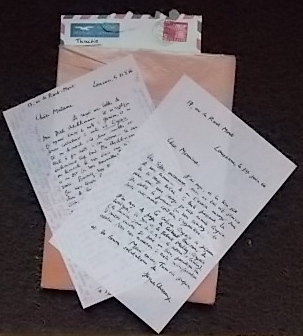
|
|
|
[CINGRIA] - CHESSEX (Jacques)
Charles-Albert Cingria 1883-1954.
Gr. In-8, 73p. Edition originale numérotée 1/150 exemplaires de tete sur papier à la cuve (celui-ci exemplaire n¡ 20, hors commerce). Contributions de Chessex, Walzer, Pieyre de Mandiargues, Follain, Pierre-Alain Tache, Dick Aeschlimann, etc... Contient un inédit de Cingria. Avec quelques illustrations hors texte. Exemplaire enrichi de 2 lettres autographes signées de Jacques Chessex (dont une avec enveloppe) à un des contributeurs de ce numéro. Contient également l'invitation au Lapin Vert pour le lancement de ce numéro, signée par Pierre-Alain Tache. A l'état de neuf, non coupé.
|
|
|
[CLARKE (William)]
Repertorium Bibliographicum; or, Some Account of the Most Celebrated British Libraries. London: William Clarke, 1819. First edition, xlviii, [2], 138, 133*-138*, 139-454, 449*-454*, 455-672, [2]pp., engraved frontispiece and 9 engraved portraits (foxed and offset, the portrait of Towneley is inserted and stands proud), small ink splash to title, 2 woodcuts in the text. [Bound with:] A Dialogue in the Shades; between William Caxton, a Bibliomaniac, and William Wynken, Clerk. Rare Doings at Roxburghe Hall. A Ballad. The Diary of Roger Payne, with a Lithographic sketch on the Monument to be Erected to his memory by the Bibliographical Club.
Second edition, [2 ads], [36]pp., with printed title-page and half-title, engraved headpiece, the advert leaf includes two editions of Beckford's Vathek and A Description of Fonthill Abbey. Small 4to (235 x 145 mm), 2 works in one, recent half calf to style, marbled boards, spine tooled in gilt. A survey of the principal public and private libraries in England, listing highlights of the collections and concluding with brief accounts of 30 important English book auctions from the 17th century onwards. William Beckford assisted in the compilation of this work, particularly in the description of his own library at Fonthill. The Dialogue in the Shades is a two-part pamphlet of satirical verse is a response to Dibdin's Lincolne Nosegay and the Bibliographical Decameron. The attribution varies from William Beckford to the Clarke brothers. This second edition is issued with an additional half-title, title-page with note from 'Mr. Wynkem' on the verso, and with the addition of The Diary of Roger Payne, a work in the same vein. A rare anti-Dibdinia item. Windle & Pippin, D9.
|
|
|
[Clement XIV].
"Al Sepolcro di Papa Clemente XIV". Manuscript copy of an anonymous sonnet. No place, ca. 1774.
8vo. Italian manuscript on paper. 1 p. Together with another contemporary copy of the sonnet (8vo, ½ p.). This unpublished sonnet was written in honour of the deceased Pope Clement XIV, who had died on 22 September 1774, and probably circulated in Rome at that time: "Chi giace in questa Tomba? Il Corpo giace / Del Gran Clemente. E l'Alma or è salita? / In grembo al suo Fattor pronto e spedita, / E di sua luce ivi trionfa e tace. / Chi piange? Il Mondo. E chi duol si sface? / Roma. Ed al duolo qual cagion l'invita? / Perchè sparendo Lui, seco è sparita / E Giustizia, e Bontà, Letizia, e Pace. / Chi fà al Sepolcro suo fregio, e corona? / Religion. Chi serba [!] la memoria? / Colui, che alla Virtude applausi dona. / Dunque in van Morte rea si vanta, e gloria, / Se in Cielo, e qui frà noi vive, e risuona, / E chiaro andrà nella futura Istoria". - The poem is a close adaptation of an elegiac sonnet in Giacomo Bratteolo's collection "Rime di diversi elevati ingegni della Citta di Udine" published in 1597. - The most consequential and controversial decision of Pope Clement XIV was the suppression of the Society of Jesus in 1773. This political act led to a surge in propaganda for and against the Jesuits and the Pope. The sonnet at hand must be seen in this context, although it does not refer to the disgraced Jesuits, choosing rather to elevate the deceased Pope as a beacon of virtue whose grave is rightfully crowned by Religion. - With minor fire damage.
|
|
|
[Clement XIV].
"Supplica che fà Roma al Re Cattolico per la Morte di Clemente XIV". Anonymous anti-Jesuit eulogy for the deceased Pope. N. p., ca. 1774.
Folio. Italian manuscript on paper. 1½ pp. In the guise of a supplication by the city of Rome to Spanish King Charles III (1716-88) following the death of Pope Clement XIV in 1774, this poem with 34 verses of 6 lines is a fiercely caustic enumeration of anti-Jesuit tropes and slanders. Among the common accusations levied against the Jesuits was the fabrication of a link between the Society and Robert-François Damiens, who had attempted to assassinate Louis XV in 1757: "Tu sai che nella Francia / Un caro a lor si cangia / In Sicario ed assase, / Perfido disleale, / Il Monarca al cospetto / Del Popol tutto per uprirgli il pecto." In one of the final verses the poem calls for Charles III, who "will extinguish the stains on the forks", to take up his sword "in every street" against those who have insulted "the majesty of the kings and of the church". - The most consequential and controversial decision of Pope Clement XIV was the suppression of the Society of Jesus in 1773. This political act led to a surge in propaganda for and against the Jesuits and the Pope. Spain had already expelled the Jesuits in 1767. - Traces of folds and insignificant brownstaining.
|
|
|
[Clement XIV].
Anonymous anti-Jesuit sonnet in honour of Pope Clement XIV. No place, ca. 1774.
4to. Italian manuscript on paper. ½ p. The premise of this unpublished eulogy for Clement XIV (1769-1774) is a comparison between the Pope and the hero Rinaldo in the enchanted forest, the most famous episode of Torquato Tasso's "La Gerusalemme liberata" with the Jesuits serving as his foe. Clement is "greater than Rinaldo and strong and brave / Inspired by heaven, supreme sheperd" who "smashed the Ignatian branch to the soil". - On 21 July 1773, Clement XIV issued the papal brief "Dominus ac Redemptor Noster" ordering the suppression of the Society of Jesus. This was probably the most controversial political decision of the 18th century, leading to a surge of propaganda for and against the Jesuits and the Pope that culminated after Clement's death on 22 September 1774. - On the verso are two quotations from Virgil's Aeneid, cautioning against hubris and blasphemy: "Discite iustitiam moniti et non temnere divos!" (VI, 620) and "Flectere si nequeo superos, Acheronta movebo" (VII, 312).
|
|
|
[COLLECTIF]
Chansonnier
s. l. s. n. s. d. (vers 1860) In-16° (158 x 100 mm), [322] ff. - [31] ff. bl. [14] ff. de table, demi-basane vert sombre, dos lisse muet orné de filets dorés et roulettes à froid, plats de papier gaufré à motif floral (reliure de l'époque).
Referencia librero : 439
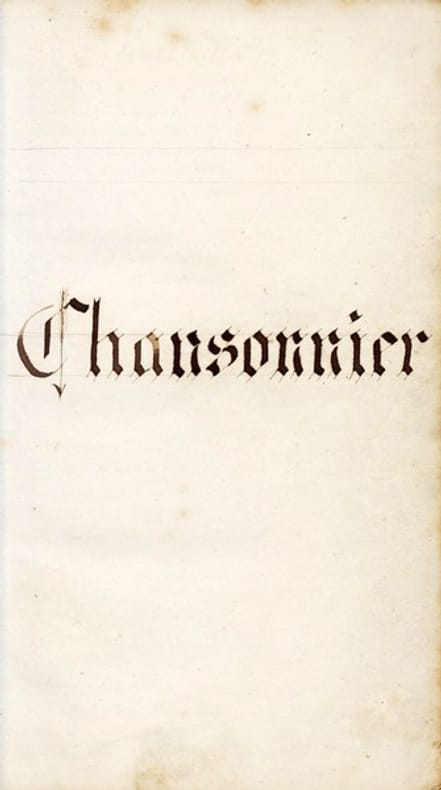
|
|
|
[Collectif]
Exposition des Primitifs Français au Palais du Louvre (Pavillon de Marsan) et à la Bibliothèque Nationale.
Paris, Palais du Louvre et Bibliothèque Nationale, Avril 1904. Un volume in-8 demi chagrin rouge, dos à nerfs, titre doré, couvertures conservées, réunissant:- Oeuvres exposées au Palais du Louvre (Peintures - Dessins - Emaux - Tapisseries): XXXII pp. d'introduction + 160 pp. + VIII pp. de table - Oeuvres exposées à la Bibliothèque Nationale (Manuscrits à peintures): 78 pp. + VI pp. de table + 32 ff. d'illustrations. Accident à la coiffe supérieure. Exemplaire de Lucien Musset, comportant quelques notes de sa main.
Referencia librero : 4565
|
|
|